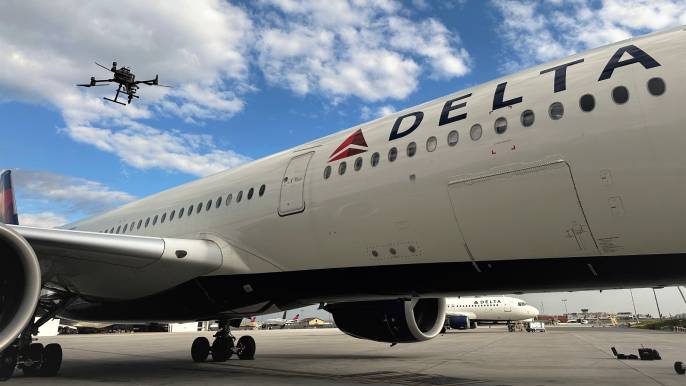
Emma Galarza, senior engineer for the technology development team at Delta TechOps
Delta Air Lines is ramping up preparations to incorporate drone-based aircraft inspections in its maintenance operations. Following several years of testing, the airline is working with the FAA to establish a path toward certification of the technology for aircraft inspections.
According to John Mathis, manager of technology development engineering at Delta, the airline began examining the use of drones for inspections in earnest starting in 2017. “We trialed just about everything on the market,” he says, noting that Delta eventually chose Dutch drone specialist Mainblades as its technology partner. The companies began ramping up testing efforts in 2021.
The airline is targeting the use of drones to assist in general visual inspections to identify damage such as dents, scratches and lightning strikes. Manual methods for these inspections require technicians to maneuver on top of aircraft using safety equipment such as harnesses, making access difficult and potentially dangerous. “It’s a slow process,” explains Emma Galarza, senior engineer for Delta TechOps’ technology development team. “You’re essentially scanning every inch of the aircraft.”
Galarza says manual inspections average around 16 labor-hours, requiring additional staff to help spot, maneuver and mark down inspection findings. The drones significantly cut down on time, taking photos of an entire narrowbody aircraft in approximately 42 min. and of an entire widebody in around an hour and 15 min. In addition to time savings, Galarza says the technology’s main benefit is safety improvements for its technicians. “Any chance we get to take our people down in height for extended periods of time is a great opportunity to increase safety,” she says.
Simplicity also has been key. Galarza says Delta spent time interviewing its technicians across different bases and areas of maintenance to find out which aspects of the technology would be most beneficial. “What’s most important to them are things like making it faster and safer, being able to set it up and use it easily, and being able to adapt to different environments,” she says.

Targeting fully autonomous inspections, Delta worked closely with Mainblades to build 3D models of every aircraft in its fleet. “We can walk up to any one of those [aircraft] and type in the registration number on an iPad,” says Galarza. Technicians then select the type of inspection they want to perform, such as a certain section or the whole upper body, and the drone associates the task to a predetermined flight plan.
“The autonomous piece is incredibly important to the success of this program,” says Galarza. “We don’t want to need specifically trained pilots to go out there and fly manually. We are looking at this to be a tool for existing procedure.”
It was also important to Delta to ensure drone inspections could take place indoors and outdoors. “When you consider a situation such as 10 aircraft that come down during a huge storm, we’re not going to have hangar space or personnel to dedicate to all those inspections, so we are targeting the use of this program for inside the hangar and outdoors on the ramp,” says Galarza. She adds that Delta is the first airline to gain approval to fly drones outside at Hartsfield-Jackson Atlanta International Airport, and it also worked closely with regulators to get permission to fly outdoors at Minneapolis-Saint Paul International Airport and Detroit Metropolitan Airport.
After a drone completes an inspection, it uploads hundreds of photos to a portal that technicians can access for review. Galarza says Delta is still evaluating the image analysis process and how much overlap is necessary for thorough inspections.
Delta has captured more than 3,000 photos during its drone trials. When asked about potential use of artificial intelligence for image analysis, Galarza noted that these photos could potentially be used as a baseline to feed into a machine learning component called assisted damage detection that could help it identify which photos need to be reviewed by a person. The airline is working with regulators to understand how it could implement this type of machine learning software. However, Mathis stresses that the sole focus right now is the use of cameras for general visual inspections.
“We are not seeking approvals for the use of machine learning; we are simply taking a stepped approach to say we see that as a potential [development] in the future,” says Mathis. “It’s really important that we set the precedent in the industry to do what is necessary first to bring comfort, acceptance and approval [for drone inspections].”
Delta is also still evaluating options for expansion of drones to the rest of its maintenance network. “Right now, we’re looking out 3-5 years. It’s kind of undetermined in terms of the number of drones we have and how often we have those available at each station,” says Mathis. “We understand this technology would be useful everywhere in the Delta system, but getting there is going to be a little bit more work.”
Galarza notes that Delta’s research and development has confirmed viability of the technology. “We have reached a point internally that we feel confident with the program and the results it provides,” she says. “Currently, we are in an active relationship with the FAA to understand what a path forward to approval looks like.”
Mainblades is also working with the engineering and maintenance division of Delta’s airline partner, KLM. The companies signed a multi-year agreement in 2021 to cooperate on achieving certification for drone-based inspections at Amsterdam Schiphol Airport.





